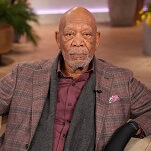A history of Hindi cinema: The 1970s, part two
The work of Gulzar, Shyam Benegal, and the incredibly influential Salim-Javed serve as highlights of the decade.

Welcome to a multi-part series on the History Of Hindi Cinema. Through individual films and the larger oeuvres of some Hindi filmmakers, we’ll explore the highlights of 70 years of cinema, starting with 1950, just three years after India won its independence from British rule, and ending in the 2010s.
Shyam Benegal’s filmography, part II
In the late 1940s and early 1950s, milk production in India did not benefit dairy farmers. Milk was taken to dairies owned by powerful local families, usually allied with monopolies, who would pay based on weight, not on quality. Farmers routinely watered down the milk by adding water, and the profits never made it to their pockets. But through Verghese Kurien’s efforts to organize villages into dairy co-ops, communities previously divided on caste and gender lines invested in their own economic self-interest. Prime Minister Lal Bahadur Shastri asked Kurien to replicate the co-op movement nationwide, which led to the creation of the National Dairy Development Board in 1965. No less inspired was Shyam Benegal, who had produced several documentaries about Operation Flood, India’s milk revolution.
When Benegal proposed a feature about Kurien’s work, the engineer turned him down, saying he never took money from the farmers he organized. Benegal countered by saying that documentaries only tended to reach those already converted to the cause. The pair compromised by asking 500,000 farmers to contribute two rupees toward the film’s production. Because the film was telling their story, the farmers agreed. Manthan (The Churning) (1976) was India’s first crowdfunded film, and also one of the best films about the difficulties of organizing workers and fighting exploitative business practices.
Girish Karnad stars as veterinarian Dr. Rao, who arrives to organize a village’s farmers into a society (a term used interchangeably with co-op). Though the farmers are frustrated by the corrupt practices of Mr. Mishraji (Amrish Puri), the owner of the local dairy, they greet Rao with either hostility and skepticism (due to his Western attire and city origins), or confusion, thinking his proposals are in aid of a political party running for election. Caste further complicates Rao’s task. Half the farmers are Harijans, considered to be a lower caste, and as long as their leader Bhola (Naseeruddin Shah, a standout) doesn’t cooperate, neither will anyone else in his community. Bhola has good reason to be suspicious; the Sarpanch (Khulbushan Kharbanda), the higher-caste head of the village council and a wealthy dairy farmer, has no desire to improve the lives of lower-caste villagers. Still, Rao remains committed despite the misgivings and warnings of his colleagues Chandavarkar (Anant Nag) and Deshmukh (the ever-reliable Mohan Agashe).
Rao’s grassroots tactics are simple. He chats with the farmers and demonstrates the scientific process of assessing a milk sample’s fat content. When villagers ask him to tend to their ill relatives, he agrees, calling it his duty since there are no doctors or government-run health clinics nearby. Slowly, the farmers begin to come around. Rao even develops a close, respectful bond with outspoken single mother Bindu (Smita Patil), who takes pride in her buffalo’s milk and is impressed by how much more the society pays for her product than Mishraji. Bhola, too, is convinced of Rao’s sincerity when he fires Chandavarkar for conducting an affair with a village girl. Still, the dairy farmers struggle to grasp the idea that Rao will not be running the co-op for them, that they will have to organize elections and deliver the product to a network of dairy collection centers themselves.
At each turn Rao encounters doubt, anger, anxiety, and prejudice; his own wife shames him for helping low-caste farmers. Nag adds comedy to the proceedings as a hypochondriac, convinced the village environs are making him sick, and Patil and Shah’s no-nonsense performances owe their authenticity not only to the actors’ talent, but to Benegal’s production. During the shooting of Manthan, the cast and crew lived on location in the village of Sanganva, and many villagers acted in the film. Benegal instructed his cast to wear the same clothes for the 45-day shoot, so their costumes looked lived-in. Shah later recalled: “I lived in a hut, learnt to make cow dung cakes and milk a buffalo. I would carry the buckets and serve the milk to the unit to get the physicality of the character.” This respect for authenticity is not a given in Hindi cinema, but Benegal’s dedication resulted in films that are better than almost everything released today.
Nishant (Night’s End) (1975), an exploration of the master-slave dynamic and the downsides of mob righteousness, would have likely made a bigger splash if it had not arrived on the heels of Ankur, Benegal’s first, better film. Still, it is no less riveting than his debut, and packs a powerful, rage-inducing punch.
Anna (Amrish Puri) is the wealthiest landowner in an unnamed village. The power he has accrued allows his younger brothers—Anjaiya (Anant Nag), Prasad (Mohan Agashe), and Vishwam (Naseeruddin Shah), the youngest—to act with impunity, stealing vegetables from the open-air market, sexually harassing village women, and bullying anyone they deem susceptible to their casual emotional violence, all while frightened villagers watch in silence. In the 1980s and 1990s, Puri minted money playing bad guys in commercial Hindi films, but his early career was filled with laconic roles. Here, extended sequences focus on the strange eroticism of the colonizer, controlling the minds and lives in a country that was itself a colony: Puri is profiled shirtless while he shaves his body hair, or reclines in the sun while his brothers wreak havoc.
Vishwam offers weak protests to his older brothers’ debauchery, but his Jell-O spine means he winds up being party to their plans anyway. He is also the only married brother; his wife Rukmini (Smita Patil) maintains the emotional equilibrium of the household, but scolds Vishwam when he vomits after binge drinking with his brothers.
Into this powder keg arrives the new, unnamed schoolmaster (Girish Karnad), his wife Sushila (Shabana Azmi), and their little boy (Altaf). Vishwam’s brothers notice him eyeing Sushila and kidnap her. Kept in a storeroom in the brothers’ house, she is gang-raped next to some unused furniture and sacks of lentils and rice, though the depravity of her imprisonment is merely hinted at. Cinematographer Govind Nihalani’s camera briefly shows the brothers’ leering faces, but mostly bears witness to Sushila’s shame and exhaustion as she wakes each morning, the memory of the night before slowly flooding back.
Vijay Tendulkar’s screenplay adds layer upon layer of complexity to the two worlds: the village and Anna’s house. As Sushila was wrestled away from the door of her own home, her husband attempted to fight back, but was punched and pushed away by the perpetrators. What stuns him is that none of the dozens of onlookers moved. As Sushila is driven off, the schoolmaster rages at his neighbors, who uselessly walk behind him in a neutered show of support. He rejects this solidarity, and tearfully goes home. This prolonged uncut shot further agonizes the audience.
The world beyond the village is equally unfeeling. Lawyers to whom the schoolmaster appeals shake their heads, saying no woman would corroborate such a story due to the reputational damage she would incur. The cops plainly tell him that lodging a complaint against Anna’s family is an act of madness. Newspaper editors refuse to publish the allegations, saying they could be sued for libel. The helpless schoolmaster doesn’t even realize that while he is struggling to gather support for his cause, his wife is being told that he doesn’t care about her, that he isn’t bothering to try and free her. Desperate to retain any sense of control, Sushila demands separate dishes so she can cook for herself and Vishwam, arguing that she is now a de facto wife and deserves her own kitchen. Rukmini immediately spirals, wailing that she’s being replaced. The dynamic between the women changes, but somehow, is not broken, as Rukmini seems to understand what Sushila is trying to do, which begs the question: How many times has this exact scenario, wherein a woman is kidnapped and kept as a sex slave in Anna’s house, played out before?
When Sushila runs into her husband at the temple—the temple whose priest has counseled the schoolmaster to do nothing but be faithful—she attacks his perceived laziness and lack of urgency. Why aren’t you trying, she says, her voice shaking with rage, to burn down the house where I’m imprisoned? This appeal to violence, the same violence, Tendulkar’s screenplay suggests, that is embedded in the minds of all Indians regardless of caste or gender, does not go unheeded. The schoolmaster teams up with the priest to rouse the villagers into action, using stories from Hindu mythology to justify their actions. But the writing doesn’t glorify these actions. Religion may be the only tool available to finally cut through the villagers’ years of repressed anger and frustration, but their revolution is a blunt instrument, a tangible form of violent masculinity, unheeding of who it holds responsible. The people who will suffer even after the revolution is complete are the same people who were victimized to begin with: women.
Smita Patil was only 22 when she outdid any actor before or since in Bhumika (The Role) (1977). Based on Marathi actress Hansa Wadkar’s autobiography, the non-linear film begins in the sepia-toned 1930s, during the childhood of a strong-willed, impetuous girl named Usha who is forced into show business upon the death of her alcoholic father. Her mother Sushila (Sulabha Deshpande), the daughter of a Devdasi family, resents not only her marriage, but her daughter’s career and newfound fame—not because she is jealous, but because she thinks it brings shame upon the family’s commitment to art, not commerce. Egging on Usha’s career is creepy family friend Keshav Dalvi (Amol Palekar), who is a decade older than the child but is clearly obsessed. Wadkar once wrote that as soon as her mother falsely accused her of a transgression, she made sure to go out and do just that. Usha’s mother falsely accuses her of having an affair with Keshav, so Usha sleeps with him. Though she’s excited about the resulting pregnancy and hasty marriage, Usha’s expectations collide with reality, as Keshav manipulates her into continuing to work as his business hasn’t taken off. Over time, his abuse expands from emotional to financial, sexual, and physical. She leaves him, their teenage daughter, and her mother for a drab hotel.
Usha explores bonds with other men, none of which bring her any satisfaction. First is with her co-star Rajan (Anant Nag), who loves her sincerely; she is grateful for his friendship but does not return his affections, saying, “You are the one who has only given to me, and never taken anything.” Her second liaison is with Sunil (Naseeruddin Shah), a director who’s read a little too much Nietzsche. Her final affair is most frightening. Usha meets businessman Vinayak Kale (Amrish Puri) at her hotel. He brings her to his rural family estate where, for the first time in her life, she is treated with any kind of respect as a wife, albeit a de facto one. Usha receives a warm welcome from Vinayak’s mother, but there is another Mrs. Kale in the house, namely Vinayak’s second wife Yashwant (Rekha Sabnis), who is bedridden due to paralysis.
The terms of Usha’s new life are revealed when the family chauffeur rejects her request to get the car out. Vinayak calmly explains that no woman has ever left the grounds. Not his mother, not his wife, no one.
Here, Yashwant crystallizes Bhumika: “The beds change, the kitchens change. Men’s masks change, but men don’t change.” Bhumika features snippets of all the films Usha acts in, and each reflects Yashwant’s warning. Whether she plays a dancer in a royal court, or a forlorn woman calling to her lover in a garden, or she defends herself in a court, asking to be judged via agni pariksha (trial by fire), Usha’s roles are defined by men. No matter what you do, no matter how much you fight back, the Indian woman does not have an out.
Despite the litany of excellent performances in Bhumika, the film belongs to Patil. Three stages of Usha’s life are shot in three different film stocks: sepia for childhood, black-and-white for adolescence, and full color for adulthood. This was due to a film stock availability issue, but it winds up enriching the narrative as Usha’s wider world becomes more informed, more detailed, and more disheartening. Patil remains one of very few prominent dark-skinned actresses in Hindi cinema, and Govind Nihalani’s camera leans in for gorgeous close-ups that convey a rich tapestry of emotion. When Usha moves, either dancing on set in a film or collapsing to the ground after a fight, Patil carries the narrative forward with her physicality. Rage flashes in her eyes like lightning, and during moments of great stillness, it’s as though the universe itself is holding its breath for her. Despite a tragic early death due to childbirth complications in 1986, Patil set a standard for Hindi film acting that precious few have approached.
Gulzar, master of naturalism: Parichay (Introduction) (1972), Mausam (Seasons) (1975), Khushboo (Aroma) (1975)
A film written and directed by Gulzar is immediately recognizable. The characters are ordinary people, dressed in common saris or kurtas. Many are grappling with emotional turbulence threatening to upend their very souls. Most intriguingly, the characters often confess their inability to handle psychological turmoil, but seek help or redemption. This holds true for three of his best from the 1970s.
Ostensibly, Parichay is a riff on The Sound Of Music. Five orphaned children live with their irascible grandfather and abusive great-aunt; no matter who he hires, the grandfather can’t keep a tutor employed long enough, as the children’s mischief causes them to flee in terror, until a new teacher arrives and turns it all around. Ravi (Jeetendra) is a college graduate battling rampant unemployment. One of the film’s best sequences features a job interview in which a retiring clerk explains the humdrum rhythms of his work life to Ravi. Shaken by the fact that he’ll never again hold the position that defined his life, paid for his son’s wedding, and made him feel worthwhile, the elderly man begins to simultaneously weep and laugh as Ravi watches in empathetic silence. This is not who he wants to be in 23 years. He doesn’t take the clerk job, but accepts a post in the home of Colonel Roy (Pran, cast against type in a career-best performance).
The Colonel’s mansion is fraught, filled with unhappy adults and unhappier children. Decades ago, Col. Roy kicked out his son Nilesh (Sanjeev Kumar) for not only pursuing a career in music, but for marrying a woman of his own choosing. Nilesh and his wife Sujata (Gita Siddharth) had five children, the oldest of whom, Rama (Jaya Bhaduri), becomes responsible for her siblings when their parents become ill and die. Col. Roy brings his grandchildren to live with him, but admits to Ravi that he does not know how to convey his love to them, nor is he able to do anything but arrange for tutors who can civilize the “savage” youngsters. Ravi promises to try.
His methods are markedly different from his predecessors’. Instead of scolding the children for their pranks, or forcing them to study, he asks them to close their books, telling them he knows he can’t teach them and that they won’t learn. Despite their continued antics, Ravi strives to get to know them, and even defends them to their grandfather. Shocked to hear the children aren’t permitted to play outdoors or sing or laugh, Ravi begins breaking Col. Roy’s rules and takes them on field trips. (The song the group sings during their outing definitely resembles Julie Andrews & co. singing “Do-Re-Mi,” only with the phonetic sounds of the Indian scale “Sa Re Ke Sa Re.”) Ravi even unlocks Nilesh’s room, kept shut since his departure, and plays the late singer’s sitar, which endears him to the children. Slowly, their behavior begins to thaw, and they begin studying willingly. By the end of the film, happy, grinning grandchildren climb into their grandfather’s bed, and the old man, smiling and weeping (in a way completely different from the retiree at the film’s start), says, “I’m so thankful Ravi introduced me to my grandchildren.”
This type of filmmaking is rare in present-day Hindi cinema. Yes, it’s common enough for filmmakers to assemble ideas from Western films (Salim-Javed turned it into a career), but what isn’t common is Gulzar’s control. He never pushes a scene or dynamic past its reasonable limits. Parichay also stands the test of time because its themes remain relevant. Unattended grief is compelling on its own, but it’s aided by R.D. Burman’s beautiful songs. “Musafir Hoon Yaaron” (“Friends, I’m a Vagabond”), sung by Ravi as he travels to Col. Roy’s house, was written by Gulzar and scored by Burman when the latter was separating from his wife. It’s an all-time classic Hindi film song, loved for its rhythm—the strumming of the guitar matches the clip of the horse-drawn carriage Ravi is traveling in—and simple but meaningful poetry about his mental push-pull (“Day took my hand and seated me here / the night gestured and called me there”). It’s a crime that Jeetendra never won an award for his acting; his performance as Ravi marries a profound sensitivity with a sense of ease. If only every adult entrusted with the care of children could be this loving.
On the other side of things, Mausam (loosely based on A.J. Cronin’s The Judas Tree), is one of Gulzar’s more prickly films. If the characters of Parichay were dealing with immense emotional trauma, then everyone in Mausam should check into a psych ward as soon as possible. As a young man, Dr. Gill (Sanjeev Kumar) falls in love with Chanda (Sharmila Tagore), the daughter of a healer in the mountains of Darjeeling. He studies for his exams and roams the hillsides with her, rhapsodizing about their future. Madan Mohan’s incandescent songs, combined with the elegant simplicity of Salil Chowdhury’s background score and K. Vaikunth’s lush cinematography, add layer upon layer of feeling to the narrative. Though he promises to come back and marry her, he never does, and upon his return 25 years later, the now-wealthy Gill searches in vain for Chanda. He is wracked with guilt to learn that, upon the death of Chanda’s father, she was married off to an elderly disabled man, gave birth to a daughter named Kajli, went mad, and died. It somehow gets worse: Kajli was molested by her brother-in-law, and installed at the local brothel. Most shockingly of all, Kajli (Tagore) is the spitting image of her mother, as crude and irreverent as Chanda was genteel and charming.
If Parichay’s Ravi did everything right, Gill does everything wrong. It makes sense, to him, to buy Kajli from the brothel, bring her to his holiday home in the mountains, and try to reform her as some sort of penance for his treatment of Chanda. Never does he stop to ask Kajli if she wants this. Kajli only knows a few types of male behavior, and as a result of a sudden influx of comparative kindness, begins to fall in love with the man who inadvertently caused her mother’s untimely death. The shame of being a sex worker floods back one day, and she comes onto Gill fairly aggressively. Disgusted, he slaps her (not for the first time), and kicks her out.
Gulzar aided his actors in delivering some of their finest work, but he didn’t just save this skill for his leads. Kajli has a pivotal conversation with Gangu Rani (Dina Pathak), the brothel’s madam, who had gladly sold her off. The young woman says Gill is the first man who looked at her like a woman, not as a sex worker, but has yet to touch her. Gangu Rani’s monologue is direct, but evocative:
“Do you love him or does he love you? Your tune has changed too. Look, daughter. The stairs of a brothel never descend into someone’s home. Never have I seen a woman leave this place and set up a home. Never have I seen that much courage in a man…But for the first time, I saw an upright man. He sounded so honest. That old man of yours, he came to see me too. To pay for you…Gave me a blank check, for me to write whatever I wanted. This never happens, daughter. But, if among the hundreds and thousands, I can save even one just once, then I’ll have honored my duty as a woman. If he accepts you, then go. Go. I don’t want anything. Not a penny.”
If the morality of the proceedings seem dubious—if they give one the ick—it’s because nothing could be more questionable than trying to rescue a woman just to save your own lost soul. Nothing could be more questionable than getting the woman who looks like your dead lover to fall in love with you. Gill hoped to find Chanda happily married, to share a cup of tea and some memories. Instead, he found that the disaster wrought by his own ego can in no way be salvaged to somehow improve his present. (To a certain degree, Mausam shares DNA with Vertigo.) It is difficult to imagine what, if anything, could improve the lives of everyone involved that also respects their agency, and the only thing everyone seems to agree on is that Kajli is better off not being a sex worker. All other wounds remain unhealed, all other sins remain unforgiven. The rest is left up to fate.
Ineffective men are a theme for Gulzar. The source for Khushboo is a novel by Sarat Chandra Chatterjee, whose most famous work, Devdas, is the ur-text for feeble men. Here, Kusum (Hema Malini, a career-best performance) was betrothed in childhood to Vrindavan (Jeetendra). When Kusum’s father dies in a land dispute riot, her family erroneously blames Vrindavan’s family, which calls off the wedding. Kusum cannot accept this; she’s already tattooed her husband’s name on her arm. Years go by and she refuses to marry anyone else—neither happy nor unhappy to remain single, but in possession of her choice—living at home with her bachelor toy-seller brother Kunj (Asrani), who cannot marry until his sister does. She has been the subject of village gossip, but has borne it all silently. When Kusum and Vrindavan run into each other, as he begins treating plague patients in her village, they reflect on their aborted relationship. Though Kusum never married, Vrindavan clearly did; he has a young son Charan (Raju Shrestha), whom Kusum takes an immediate liking to, but his wife has since died.
Though everyone supports Kusum finally joining Vrindavan as his wife, Kusum refuses. Vrindavan’s mother leaves two gold bangles at Kusum’s home as a gesture of her approval, but Kusum has her brother return them. (Khote’s reaction shot is a testament to her skill, displaying a fast-moving blend of wounded pride, sorrow, and disappointment.) Before she agrees to anything, she wants an apology, an acknowledgement of her loss and loneliness. She wants affirmation that she should never have been held responsible, nor had her fate altered, by the actions of her relatives, and says as much in an agony-filled monologue:
“It’s not as though I’m sitting on the side of the road, that they can decide when they want to leave me and when they want to take me. That everything will happen according to [Vrindavan’s] will. That I’m nothing, that I’m no one. Not once did he ask how I’ve spent all these years, how I’ve been living, how I’ve been dying. He wanted to, so he broke our engagement. He wanted to, so he married someone else. Now he wants to, so he told me to go with him. As though nothing happened. As though I’m a beggar-woman on the side of the road.”
Kusum spends more time with Vrindavan, and hears his side of the story. He wasn’t aware of the reasons for their broken betrothal, and had continued his studies. During a hunting trip, Vrindavan encountered Lakhi (Sharmila Tagore in a brief but powerful role) and her blind grandmother, abandoned in their poverty-stricken village. Lakhi too was married off as a child, but her husband abandoned her 15 years ago. She was shocked to receive a visitor. Tagore’s heartbreaking delivery is drenched in bottomless isolation: “Today, years later, I felt as though I’m still alive. That I live in a community.” Lakhi’s grandmother mistook Vrindavan for her missing grandson-in-law, was overwhelmed with relief, and died soon after. Now alone in the world, Lakhi attempted suicide, but was caught in time by Vrindavan, who took her to his home and married her, only to lose her to illness a few years after she gave birth to Charan.
Despite observing firsthand the effects of societal alienation on women, Vrindavan seems wholly incapable of investigating Kusum’s refusals to be his wife. Jeetendra’s performance is terrific in its ambiguity, but Khushboo belongs to Malini. The actress said, years later, that she didn’t realize how liberating it was to simply put on a non-matching sari and blouse and act: “I was too young to realize what kind of a strong character I was playing in [Khushboo], but this changed my image—I didn’t have to wear bell-bottoms and fancy wigs or run around trees.” (A possible reference to the theatrics required of her in Seeta Aur Geeta.) Malini is equally comfortable in warm scenes with Charan, whom she teases and plays with and longs to mother, as she is in quiet scenes where she summons the full strength of her steely spine. She may not have a lot of rights, but she is asserting the right to her own pride.
Writer-kings Salim-Javed, part II
At the 1976 Filmfare Awards, Salim-Javed were nominated for two of the best Hindi films ever made: Sholay and Deewaar (The Wall) (1975). They swept each category, but only for Deewaar. And, though both are exemplary, Deewaar is the better film. The dialogue does not feature a superfluous syllable, and each scene is so tight that director Yash Chopra didn’t need to do more than follow the script’s path. The acting is a revelation, and the story altered the course of Indian history.
Deewaar pulls from various sources, namely the 1961 Dilip Kumar film Gunga Jumna, in which an older brother, seeing wealthy villagers inflict pain upon peasants like his mother, sets aside his childhood for the comfort and education of his younger brother. Over time, the two find themselves on opposite sides of the law. Mother India follows a similar storyline, but Salim-Javed moved the tale of warring brothers from the country to the city. Deewaar also borrows from early American gangster films like The Public Enemy.
At the film’s start, police inspector Ravi Verma (Shashi Kapoor) is receiving a medal for courage. He requests that his mother Sumitra (Nirupa Roy) receive the medal instead, as she is responsible for everything he is today. As the crowd cheers, Sumitra is guided to the stage and clasps her son’s medal. She looks off into the distance and so begins the flashback that comprises the bulk of the film.
Images common in the news at the time are replicated early in the story: Sumitra’s husband Anand (Satyen Kappu) worked as a union leader. The strike he led reflected strikes breaking out all over India in the 1970s, which were part of Prime Minister Indira Gandhi’s rationale for declaring a State of Emergency. The evil boss blackmails Anand into agreeing to his terms by kidnapping his wife and their two boys, Vijay and Ravi. Violence ensues: Anand is beaten by his fellow workers, and a group of men drag Vijay to a tattooist, whom they pay to write “My father is a thief” on the boy’s arm.
Unable to bear the shame, Anand disappears, and his family leaves for Mumbai. The destitute trio live under a highway overpass in the slums of Dharavi. With his mother’s permission, Vijay, noticing Ravi admiring schoolchildren marching to class, stops his education and starts shining shoes so he and his mother can pay Ravi’s school fees. Though his love for his mother and brother is sincere, Vijay routinely lashes out. When angrily questioned as to why he cannot act like the well-behaved Ravi, Vijay says, “We are different,” and points to his tattoo.
Years later, the divergent lives of the brothers have taken a toll on their personalities. Though Ravi is an accomplished college graduate, he cannot get work because every hiring manager has a boss whose nephew or son-in-law needs a job. Vijay (Amitabh Bachchan) is a stoic dockworker who goes to the local temple every day with his mother and brother, but does not pray.
Salim-Javed’s screenplays frequently invoked Islam as an association with the struggles of the urban poor; this also became an essential component of Bachchan’s on-screen personality. When Vijay vows to fight back against local gangsters, he sits in the canteen under a photo of Gandhi, rejecting the non-violent practices that led to Indian independence for something more individualistic, gritty, and assertive. This juxtaposition led to a philosophical shift in Hindi cinema, and India as a whole—an industry that previously prized gentleman heroes was about to take a sharp turn towards vigilante justice and guttural violence. Vijay single-handedly dispatches the goons in a sequence that was unusual for Hindi cinema at the time, and more influenced by Hong Kong martial arts films, employing acrobatics and stunts.
Vijay’s success catches the eye of a wealthy smuggler, who hires him to run his operation. Vijay thrives in the role, while Ravi joins the police instead. For his very first assignment, he has to investigate a local smuggling ring. He balks when the file handed to him includes the name and photo of his brother. After refusing the assignment to hunt his brother, Ravi chases and shoots a thief—then is dismayed to discover that the thief is a young boy, stealing bread to feed his impoverished family. If Salim-Javed had dared to have Ravi question the nature of policing as a whole, India might be a different country today. Instead, the ashamed young inspector vows to fight large-scale crime, like the kinds perpetrated by his brother.
There are three extraordinary confrontations in Deewaar. First is a showdown between Vijay, Ravi, and Sumitra; the second is between the brothers, and the third is between Vijay and god. Each is more explosive than the last. Perhaps the most important feature of the writing is that no one, not Vijay, Sumitra, nor Ravi, is really wrong. But most long-lasting is Vijay’s interrogation of god. It’s a contender for the best monologue in the history of commercial Hindi cinema; certainly there has never been a monologue that better distilled a character’s psychology. Animosity directed at god, verbalized by the (anti)hero, was a complete novelty in Hindi cinema. Some perceived it as sacrilegious. All were enthralled.
It is difficult to overstate the influence of Deewaar, not only on the Indian public, but on cinema in general. Residents of the Dharavi slum, where Chopra set the city lives of Ravi and Vijay, felt honored and gratified that a handsome, famous movie star was giving voice to their crises and struggles. Danny Boyle cited the film as his inspiration for directing Slumdog Millionaire, which was also set in Dharavi; in his Oscar acceptance speech for “Jai Ho” winning Best Original Song, composer A.R. Rahman quoted dialogue from Deewaar in order to—what else—thank his mother. And though the Hong Kong film industry is thousands of miles away from Mumbai, Deewaar helped set the stage for the “heroic bloodshed” genre. John Woo’s A Better Tomorrow and Hua Shan’s The Brothers are remakes of Deewaar. The film was also remade in Telugu, Tamil, Persian, Turkish, and Malayalam. Its screenplay is studied and analyzed in Indian film schools. It is a film that will live on as a turning point for not only an entire film industry, but for a nation that was only 28 years old at the time of its release.
For Sholay (Embers) (1975), writers Salim-Javed drew inspiration from Seven Samurai, Once Upon A Time In The West, and The Magnificent Seven, along with older Hindi films like Ganga Jamuna and Khote Sikkay. The logline is simple: a retired cop hires two thugs to capture, not kill, a dacoit who has been terrorizing the former’s village. The result is a film that enjoys a supernatural bond with its original score, that invokes every human emotion, and that remains one of the highest-grossing Indian films of all time.
Starring in the roles that changed their lives are Amitabh Bachchan as Jai, a tall, laconic thief who practically holds degrees in marksmanship and sarcasm, and Dharmendra as Veeru, a stocky thug unafraid of violence and overconfident with women. Unusually, they were not anti-heroes; the dialogue hints that poverty compelled them to become petty thieves, but no other information about their background exists. But there was not a soul in the audience who wasn’t rooting for them.
Once, inspector Baldev Singh (Sanjeev Kumar) arrested the pair; when bandits attacked their train, Singh was impressed by Jai and Veeru’s bravery in fighting them off. (Vulture ranked the scene as #31 on their list of “The 100 Fights That Shaped Action Cinema.”) Years later, he approaches them to apprehend Gabbar Singh, a depraved bandit who lives in the mountains above his village, alive. He refuses to say why, but promises Jai and Veeru Gabbar’s bounty.
Gabbar (Amjad Khan, in a terrifying debut) was an altogether new type of villain. Instead of dressing in traditional Indian garb, he wore fatigues. He spoke in a mixture of Khariboli and Awadhi dialects, laughed in a low, gentle, sneering tone, and his roaring commands punctured the mountain air like bomb blasts. Salim-Javed opted to provide no reason for his career as a bandit. In his villainy, Gabbar is free.
Rounding out the cast are Bachchan’s future wife Jaya Bhaduri as Radha, whose unspoken romance with Jai provides mellow pauses in an otherwise hectic narrative, and Hema Malini, who plays chatterbox carriage driver Basanti, with whom Veeru falls hopelessly in love.
There is no end to scholarship on Sholay. Dissertations have been written on its acting, allegories, impact, and inconsistent ideology. But what doesn’t get as much analysis as it should is the film’s score. R.D. Burman was no stranger to innovative compositions that heightened a film’s atmosphere and impact. His work for Sholay, however, binds with the narrative.
The opening credits honor Ennio Morricone more than a little. A policeman and servant ride a horse through valleys and mountains. At first, a single guitar. Softly, slowly, the rhythm and bass guitars combine with a gentle conga drum melody—all in perfect sync with the canter of the horses onscreen. A horn plays the melody; beautifully elongated notes signal the beginning of a lengthy horse ride, and the beginning of a brilliant movie. Then the goosebumps-inducing rat-a-tat of the drums gives way to scores of violins gliding in, sending the film’s energy soaring.
The title credits aren’t just stirring music. They set up themes and homages that Burman returns to throughout the film. The guitar, whistle, horns, and violins are a nod to classical Westerns, referring to the deep friendship between Jai and Veeru that forms Sholay’s core. When the film moves to the village, the music switches to distinctly folk-influenced melodies, signifying a bucolic existence. And the inclusion of minor chords is significant, because as rabble-rousing a film as Sholay is, it is a dark, violent tale, featuring lies told by people who trust each other, and copious, senseless death.
Burman extended these motifs throughout the film. “Yeh Dosti” (“This Friendship”), sung with great elation by Manna Dey as Jai and Kishore Kumar as Veeru, proudly proclaims that for each other, they’ll take lives, they’ll eat and drink together, they’ll live and die together. The chief villain gets his own theme too. During a massacre, Burman halts the music completely, using only the metallic scrapes of a swingset, swaying back and forth in the wind, to create intense levels of anxiety. But the best music for a supporting character belongs to Radha (Bhaduri). The cheerful folk music of her youth is contrasted against her theme in the present; embodying her life’s tragedy, it is minimalist, truncated, featuring nothing more than a harmonica, a guitar, and a synthesizer (used for the first time in Hindi cinema on Sholay).
Despite Sholay’s great score, terrific acting, and stylized direction (it was the first Hindi film to have a stereophonic soundtrack and use the 70mm widescreen format; CinemaScope’s logo was prominently featured on its posters), the film is not without flaws. The song “Koi Haseena” is a textbook example of rape culture, and Sholay—with no clear social message—capitalized on a nationwide thirst for escapism and violence. Yet, the audience wanted a masala film, and Sholay provided. It changed not only Hindi cinema, but the lives of its leads. Bhaduri and Bachchan, married in 1973, were expecting their first child during shooting, and five years after the release of the film, Malini and Dharmendra married. Sholay shot Bachchan and Dharmendra into superstardom, though the latter got stuck in dimwitted, loyal, wisecracking thug roles.
And yet, at the time, the film almost bankrupted its producers. Outraged that their mammoth undertaking was tanking, Salim-Javed personally paid for newspaper ads that announced their film would take in one crore rupees in each Indian territory. The combination of the ads’ confidence, plus the blockbuster sales of records that featured the film’s dialogue, turned Sholay’s fortunes around. The creative team had been discussing reshoots on a Friday. By Monday, the film was a box office smash.
The comedies of Hrishikesh Mukherjee: Chupke Chupke (Quietly) (1975), Gol Maal (Topsy-Turvy) (1979)
Although Chupke Chupke is one of the best Hindi-language comedies ever made, it is perhaps the one film that cannot be effectively translated for English-speaking audiences. The plot, adapted from the original Bengali film by Agradoot, is delightfully madcap: Botany professor Parimal Tripathy (Dharmendra at his dreamiest and most charming) has just married Sulekha Chaturvedi (Sharmila Tagore). The couple share an impish sense of humor and enjoy practical jokes. What is less enjoyable, at least for Parimal, is his wife’s incessant praise of her brother-in-law Raghav (Om Prakash in peak comedy mode). Unable to attend their wedding, Raghav writes to Haripad (David), Sulekha’s older brother, requesting the newlyweds come to Mumbai for a holiday. In the same letter, which is written in stuffy, old-school Hindi that Parimal compares to a newscaster on All India Radio, Raghav requests Haripad’s aid in finding a well-spoken, responsible chauffeur. Parimal hatches a devilish scheme: given that neither Raghav nor Sulekha’s older sister Sumitra (Usha Kiran) know what he looks like, he will travel to Mumbai as a chauffeur named Pyare Mohan in order to test his new brother-in-law’s intellect. Sulekha and Haripad are skeptical but, amused, agree.
So begins Raghav’s nightmare. Pyare Mohan checks a lot of boxes: he knows his way around car trouble, he’s cheerful, and most importantly for the stuffy Raghav, he doesn’t use any errant Mumbai slang. But Raghav is deeply, hilariously offended that Pyare Mohan’s Hindi is even more pure than his own, and, to add insult to injury, the man won’t shut up about the irregularity of English grammar and phonetics compared to Hindi. Of further worry is the new driver’s declaration that he will make good use of his employ in the household of such a learned man, and his purchase of an English-language workbook that he insists on poring over with Raghav when he gets home from work. Sulekha arrives in due course, relishing the situation, and she and Parimal quietly share a bed at night. This too, at some point, does not go unnoticed, and after Raghav and Sumitra question them separately about their behavior, the pair run away together.
Because the film is mocking a man’s penchant for linguistic pedantry, it simply would not make sense if it were translated into English. A significant portion of the dialogue makes excellent use of the flexibility of Hindi through syntax, repetition, and word choice. Subtitles that properly conveyed the film’s ideas and events would require footnotes and extensive explanations. But Chupke Chupke is a film worth learning Hindi for. It has never lost its freshness, and is as funny today as the day it was released. Let’s just ignore the fact that the plot wouldn’t exist if Raghav simply looked up Parimal on LinkedIn.
Mukherjee’s best comedies relied on the foundation of a perfectly cast straight man and a funny man. Chupke Chupke fits this mold, as does Gol Maal. It takes a quiet, simple approach to a boy-next-door type facing off against a veteran of Indian theater. Both films mock pre-conceived notions and the silliness of rigidity, finding comedy gold.
Amol Palekar was making a name playing ordinary men in ordinary situations, largely in romantic comedies and slice-of-life films. In Gol Maal he is Ram Prasad Sharma, seeking work post-college exams. Gifted with a lovely voice, he spends his time singing at parties with friends, organizing picnics, and watching films. Ram is dedicated to finding employment so he can arrange the marriage of his sister Ratna (Manju Singh). He also has a mustache; this is important later. Ram gets a job at Urmila Traders, owned and run by Bhavani Shankar (veteran Bengali stage and film actor Utpal Dutt), a man of seemingly inflexible and irrational moral standards, including prizing the usage of pure Hindi, and devotion to and maintenance of a mustache. “A man who is clean shaven,” he pontificates in his deep baritone, “cannot be clean of heart.”
During his job interview, Ram reveals none of his pastimes, as the mere idea of such fripperies is anathema to Shankar; this, along with wearing a traditional dhoti and kurta instead of a shirt and trousers, lands Ram the job. But his new position is less than a week old when he rushes out of the office, claiming his elderly mother is having trouble breathing. This is only technically true, as Ram’s long-dead mother probably does have respiratory difficulty, but the ticket to an India vs. Pakistan hockey final was burning a hole in his pocket. The problem is Shankar, who, contrary to everything he says, is also cheering in the stands. He spies Ram, dressed in obscene attire (an untucked, unbuttoned, brightly colored shirt and bell bottoms—the horror!), and more importantly, not at home with his unwell mother.
Caught in the lie the next day, Ram invents a twin brother, Laxman (borrowing names from the legendary brothers of The Ramayana). Ram studied accounting and has a decent job; Laxman is a clean-shaven loafer, who refuses to find work but has a beautiful voice. Ram puts on a show, trembling, voice wavering, and Shankar buys the act, begging forgiveness for rushing to conclusions. Given Laxman’s wayward ways, he declares, the good-for-nothing twin will have to be good for something and teach music to his daughter Urmila (Bindiya Goswami).
Ram shaves his mustache, buys a fake one and loads of spirit gum, and, as Laxman, trots off to Shankar’s house. This scene is a comedy touchstone in Hindi film history, as Ram/Laxman decides to let loose some of his antipathy for his weirdo boss. The scene inside is even funnier, as Laxman, meeting Shankar in a robe and glasses, fake-apologizes for calling him an old man, because “even though you are an old man, calling an old man old can cause hurt feelings.” In order to differentiate between the two brothers, Laxman, who insists upon being called “Lucky” much to Shankar’s chagrin, peppers his speech with English. Urmila enters the scene, and she and Ram/Laxman immediately fall in love. The attraction is further cemented when he sings “Aanewala Pal Jaanewala Hai,” one of the loveliest Hindi film songs ever recorded, consisting of an unbeatable combination: Kishore Kumar’s voice, Gulzar’s poetry, and R.D. Burman’s fast-paced soaring horns.
Just as Ram thinks he’s safe, his boss informs him that he’d love to pay his respects to Mrs. Sharma in person. Ram scrambles again, hiring Kamala Shrivastava (Dina Pathak), a retired social worker who acts as a hobby. Though she pulls off her performance as the widowed Mrs. Sharma, Shrivastava is spotted at a party by Shankar in a festive sari and jewelry (forbidden to Hindu widows), and then she has to invent a twin sister.
Gol Maal is an exemplary 1970s comedy, one hewing closely to the ethos of Mukherjee’s career. R.D. Burman’s sublime music—featuring captivating love songs, as well as funny, conversational numbers among Ram and his friends that comment on the perilous, mind-boggling nature of finding work and chasing dreams—helped cement the film’s place in history.
The quintessential Mumbai rom-com: Chhoti Si Baat (A Small Matter) (1975)
A remake of the successful British hit School For Scoundrels, Chhoti Si Baat stars Amol Palekar and Vidya Sinha as two people trying to find love in very different ways in Mumbai. Arun Pradeep (Palekar, cornering the market on boy-next-door roles) is a shy introvert, bullied by younger coworkers. His parents are dead and he finds it difficult to function in a world where they can no longer do everything for him. Arun’s single glimmer of hope is Prabha Narayan (Sinha, cheeky), a woman who works in the same building, but not the same office, as him. They ride the same bus to work. Every day, he follows her from the bus stop to work, then again back to her house, before going back to his own home. He never says anything, both eager and afraid to strike up conversation.
Prabha is fully aware of what’s going on, and enjoys Arun’s discomfort. One day, she actually turns around and confronts him, threatening to report him to his superiors. This is a ploy, just to rattle him, and the two strike up a friendship. Prabha watches with glee as Arun struggles to flirt or even converse with her, all while Nagesh Shastri (Asrani, typically hilarious), a confident extrovert in her own office, openly asks her out on dates. Worried about losing her to Nagesh, Arun visits everyone from tarot card readers to holy men for advice. Desperate, he seeks out a retired Colonel (Ashok Kumar) in order to get a proper education on how to successfully woo a woman.
For a film that only has three songs, Chhoti Si Baat’s music made quite an impact on Hindi cinema. The score is filled with jazzy horns and choir-like vocals, well-suited to a quieter Mumbai. In his songs, Salil Chowdhury channeled a new kind of young love, one in which Arun imagines himself and Prabha in a song he watches at the movies. The film’s title song is more melancholy, played in the background as Prabha misses Arun, intercut with his lover boy training. Its fast-paced horns and strings pair beautifully with Lata Mangeshkar’s plaintive, moody vocals.
Chhoti Si Baat is frequently lovely, with stylish moments like jump-cutting Prabha’s face into the narrative as Arun goes about his day, missing her. Basu Chatterjee’s direction and K.K. Mahajan’s cinematography capture a Mumbai that no longer exists. The streets were wide and uncluttered enough for people and traffic to move through easily. The rain gave the city a cozy, cheery patina. The various restaurants at which the characters dine speak to a burgeoning cosmopolitanism, one driven by young urban adults rather than family units.
The bad news is that Chhoti Si Baat has not aged well. School For Scoundrels celebrated the success of a man who narrowly avoids becoming an incel and instead learns to respect a woman in order to be in a healthy relationship. Chatterjee and co-writer Sharad Joshi put their own spin on things, namely glamorizing stalking. The audience is meant to condone, if not endorse, Arun’s behavior, as he does not have underhanded intentions; he protests to Prabha that he’s “not that kind of guy.” Hindi cinema is rife with endless examples of men pursuing women, often set to catchy songs, in order to convince them to fall in love, and it always works. Arun is a success story too, as the Colonel fixes him right up, sending him back to Mumbai with stylish suits, a new authoritative manner, and the ability to flirt. Prabha was always in love with him, so they don’t have far to go in their new relationship, but as Roger Ebert once said, it’s not what a film is about, but how it’s about it. As charming as Chhoti Si Baat can be, its approach to relationships and female agency feels reductive, and it doesn’t hold up as well as other comedies from the time.
Advanced studies
Trishul (The Trident) (1978): Trishul is a classic, overflowing with spitfire Salim-Javed one-liners and starring Amitabh Bachchan as a wronged orphan (once again named Vijay) out for revenge against the wealthy father (Sanjeev Kumar) who abandoned his impoverished pregnant mother (Waheeda Rehman). Watching Bachchan and Kumar tee off against each other (unlike their respectful bond in Sholay) is a treat, but the film’s third act is a mess. Still, Trishul sports some excellent action sequences and the song sung to an infant Vijay by Rehman’s character is an unmissable part of Hindi film history.
Kaala Patthar (Black Stone) (1979): Another hit masala film, starring just about everyone mentioned in this piece, directed by Yash Chopra and written by Salim-Javed. Vijay (Amitabh Bachchan, of course) is a disgraced Navy captain, having abandoned his ship as 300 passengers died. He now works as a coal miner in terrible conditions, and befriends Ravi (Shashi Kapoor, reprising the Vijay-Ravi combo from Deewaar) while establishing a mutually hateful dynamic with fellow coal miner Mangal (Shatrugan Sinha). It’s by no means the writers’ or director’s best work, but a notable film for two reasons: Kaala Patthar is one of the first times PTSD was featured as a plot point in a Hindi film, and its climax features an ambitious mine collapse, achieved with practical effects. Natural disasters were rare in Hindi cinema at the time, and Chopra, to his credit, brings a fair amount of realism to the sequence.
Hum Kisi Se Kum Nahin (We Are Not Less Than Anyone) (1977): The plot is nonsensical and irrelevant, but the songs are some of the best in 20th century Hindi film. Composer R.D. Burman took inspiration from all over, including ABBA’s “Mamma Mia” and “Honey and Honey.” His compositions run the gamut from sweet ballads to joyous, chirpy love songs to a qawwali—a style of Sufi devotional music that includes a call-and-response element—where lovers confront each other with affection and confidence. It’s addictive.
Muqaddar Ka Sikandar (The Conqueror Of Destiny) (1978): Though its plot is undeniably convoluted, this ensemble romantic-action-drama, which pulls from inspirations as diverse as Devdas and Cyrano De Bergerac, was an Indian and Soviet smash hit, owing to its stellar soundtrack (by brothers Kalyanji-Anandji) and the suspected affair between leads Amitabh Bachchan and Rekha. (Their chemistry, certainly, did nothing to dispel these rumors.)
Mr. Natwarlal (1979): Natwarlal was a real-life Indian conman, said to be as successful as Frank Abagnale. He “sold” Parliament House to unsuspecting tourists and impersonated prominent multimillionaires. He was regarded as a Robin Hood figure in his native village of Bangra, arranging giant feasts for the hungry, and giving away money to those who needed it. Director Rakesh Kumar borrowed the man’s name for his star Amitabh Bachchan, but turned his conman tendencies into a response to childhood trauma. Amjad Khan plays yet another Gabbar-like bad guy, only this time he uses tigers to terrorize innocent villagers, while village belle Shanno (Rekha) falls in love with Natwarlal; the only thing more incandescent than the diamond necklace Natwarlal is chasing is Bachchan’s chemistry with Rekha. The real-life Natwarlal objected to his name being used for the film, so the weekend before it premiered, the producers added “Mr.” to the title. If nothing else, Mr. Natwarlal is proof that there is magic not just in Bachchan’s acting, but in his voice itself.
Hare Rama Hare Krishna (1971): Another one for the “ridiculous but great songs” file. Dev Anand directs himself as a man trying to hunt down his sister in hippie-filled Kathmandu. The central thesis is “Western concepts like divorce create wayward children who do drugs,” making it similar to the ideas behind Purab Aur Paschim. But Anand was never as interesting a filmmaker as Manoj Kumar, so with the exception of the drug-filled haze of R.D. Burman’s classic ‘70s title song and newcomer Zeenat Aman’s excellent costumes, this is a bit of a snooze.
Bombay To Goa (1972): A fine little comedy-thriller, filled with great songs, that played a significant role in Hindi cinema history. Salim-Javed couldn’t think of anyone to cast in Zanjeer, and every important actor had turned the role of Vijay Khanna down. The pair wandered into their local movie theater for a screening of Bombay To Goa, and were impressed by a specific fight scene: Amitabh Bachchan—who had been in 12 films by the age of 30 but only two, including Bombay To Goa, were hits—is chewing gum while fighting off a bunch of goons in a club. He goes into a somersault, gets up, continues fighting, and keeps chewing his gum all the while. The very next day, Salim-Javed went to Bachchan’s home to narrate the story of Zanjeer. That wad of gum began a cinematic revolution.
Don (1978): Don doesn’t exactly pass the sniff test. A suave gangster is killed while on the run. No one knows of his death, so the inspector hires a man who looks exactly like the dead gangster to rejoin and infiltrate his gang. It helps that Don is played by Amitabh Bachchan in his first out-and-out bad guy role. Clearly modelled on James Bond, Don wears elegant suits, cool sunglasses, and jaunty bow ties. One of the other things Don has going for it is the introduction of a markedly different kind of heroine. Roma (Zeenat Aman) wants to avenge the deaths of her brother and sister-in-law, who were killed when they attempted to leave Don’s employ. Devastated by the deaths of her loved ones, Roma seeks martial arts training. This was a first in Hindi films; female characters, although ferocious and/or protective, did not seek to be killers. Don isn’t one of Salim-Javed’s best, but it’s still an enjoyable masala film.
GET A.V.CLUB RIGHT IN YOUR INBOX
Pop culture obsessives writing for the pop culture obsessed.






































